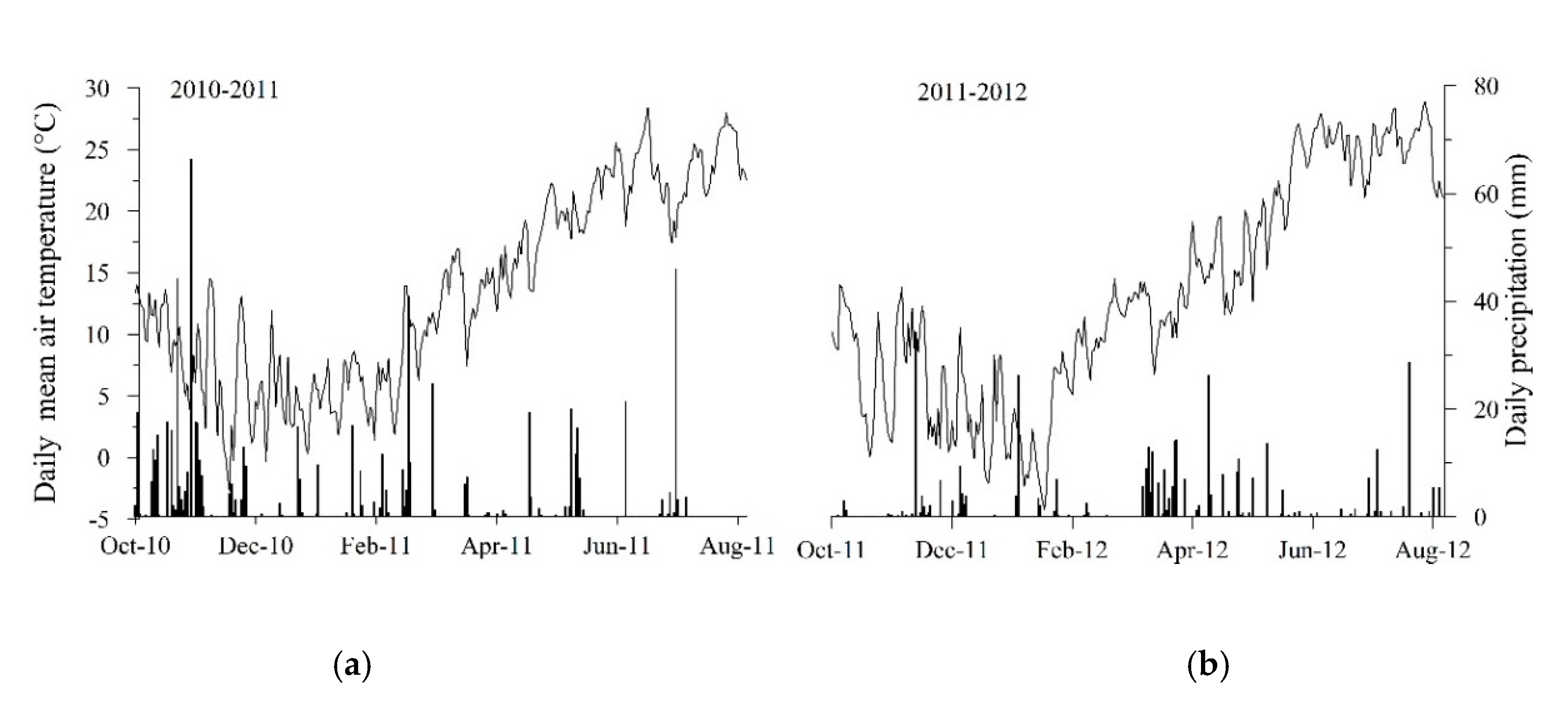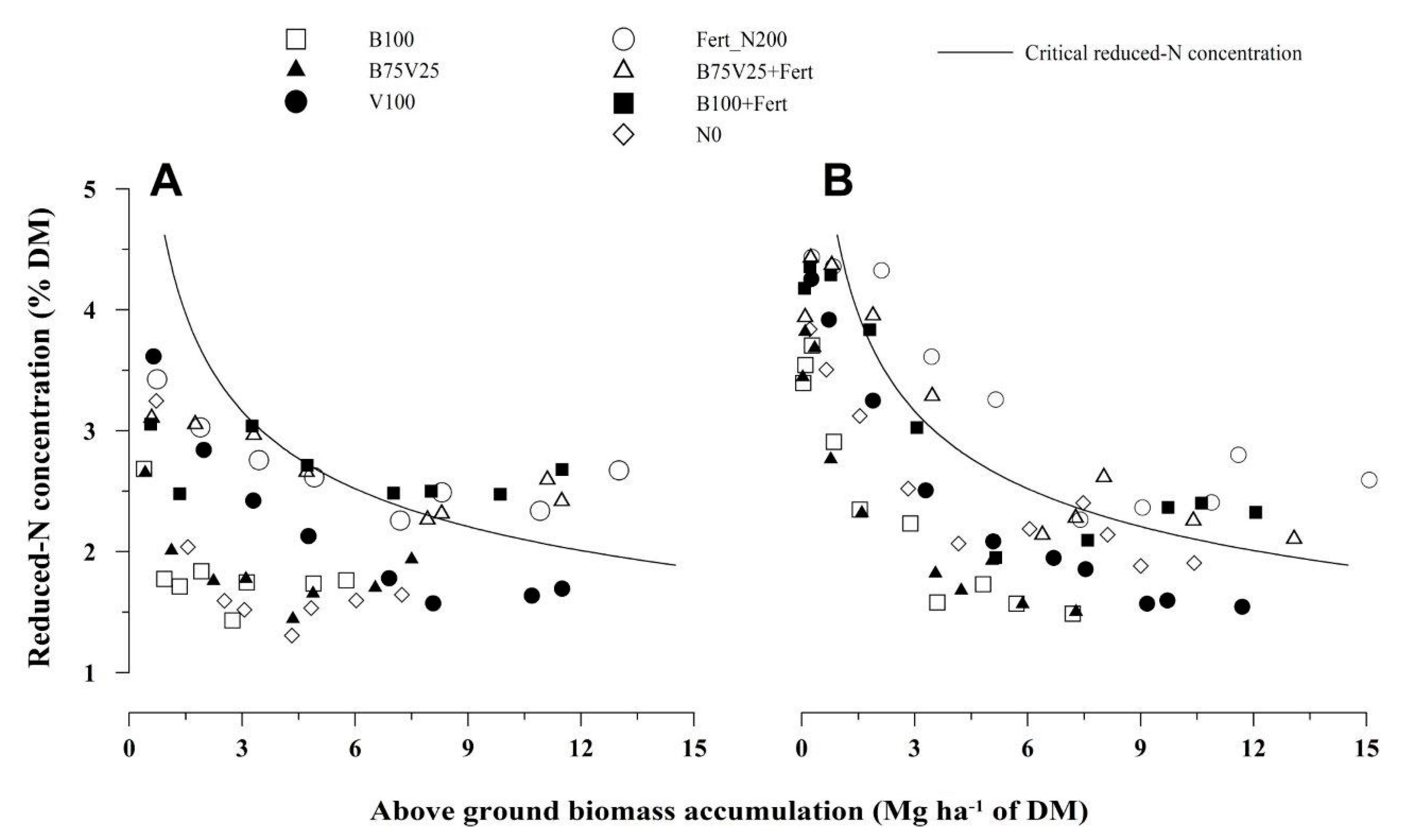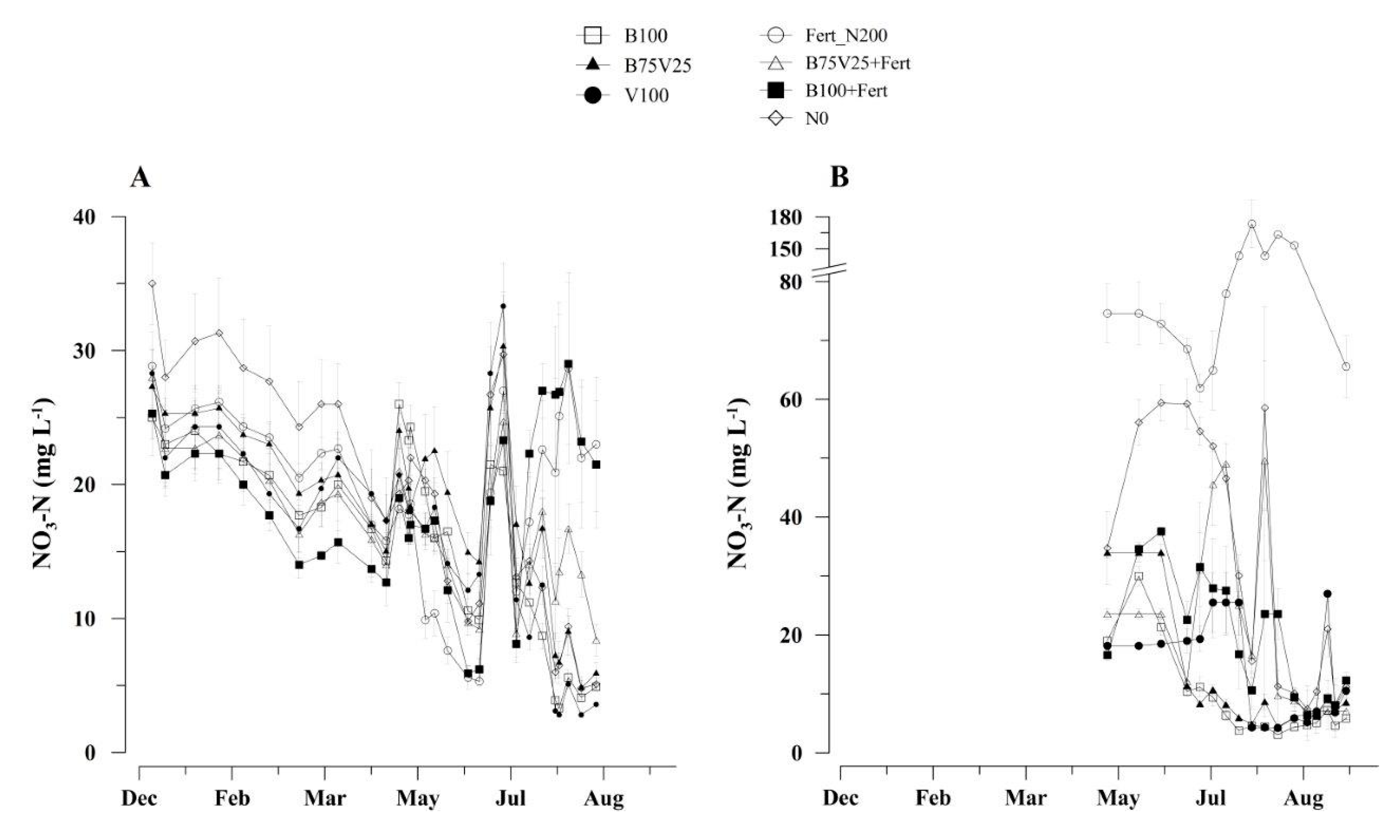Combining Green Manuring and Fertigation Maximizes Tomato Crop Yield and Minimizes Nitrogen Losses
Abstract
1. Introduction
2. Materials and Methods
2.1. Experimental Site, Treatments and Crop Management
2.2. Plant Sampling
2.3. Cumulative NO3-N Leached below 0.9 m Depth
2.4. Data Analysis
3. Results
3.1. Weather Conditions
3.2. Aboveground DM and N Accumulation in Cover Crops
3.3. Aboveground DM and N uptake, and Fruit Yield in Processing Tomato
3.4. Cumulative NO3-N Leached below 0.9 m Depth
4. Discussion
5. Conclusions
Author Contributions
Funding
Acknowledgments
Conflicts of Interest
References
- Bindraban, P.S.; Dimkpa, C.; Nagarajan, L.; Roy, A.; Rabbinge, R. Revisiting fertilisers and fertilisation strategies for improved nutrient uptake by plants. Biol. Fert. Soils 2015, 51, 897–911. [Google Scholar] [CrossRef]
- Incrocci, L.; Massa, D.; Pardossi, A. New trends in the fertigation management of irrigated vegetable crops. Horticulturae 2017, 3, 37. [Google Scholar] [CrossRef]
- Tosti, G.; Benincasa, P.; Farneselli, M.; Pace, R.; Tei, F.; Guiducci, M. Green manuring effect of pure and mixed barley hairy vetch winter cover crops on maize and processing tomato N nutrition. Eur. J. Agron. 2012, 43, 136–146. [Google Scholar] [CrossRef]
- Farneselli, M.; Benincasa, P.; Tosti, G.; Pace, R.; Tei, F.; Guiducci, M. Nine-year results on maize and processing tomato cultivation in an organic and in a conventional low input cropping system. Ital. J. Agron. 2013, 8, 2. [Google Scholar] [CrossRef]
- Farneselli, M.; Benincasa, P.; Tosti, G.; Simonne, E.; Guiducci, M.; Tei, F. High fertigation frequency improves nitrogen uptake and crop performance in processing tomato grown with high nitrogen and water supply. Agr. Water Manag. 2015, 154, 52–58. [Google Scholar] [CrossRef]
- Abdalla, M.; Hastings, A.; Cheng, K.; Yue, Q.; Chadwick, D.; Espenberg, M. A critical review of the impacts of cover crops on nitrogen leaching, net greenhouse gas balance and crop productivity. Glob. Chang. Biol. 2019, 25, 2530–2543. [Google Scholar] [CrossRef]
- Tosti, G.; Benincasa, P.; Farneselli, M.; Tei, F.; Guiducci, M. Barley-hairy vetch mixture as cover crop for green manuring and the mitigation of N leaching risk. Eur. J. Agron. 2014, 54, 34–39. [Google Scholar] [CrossRef]
- Shah, S.; Hookway, S.; Pullen, H.; Clarke, T.; Wilkinson, S.; Reeve, V. The role of cover crops in reducing nitrate leaching and increasing soil organic matter. Asp. Appl. Biol. 2017, 134, 243–252. [Google Scholar]
- Meyer, N.; Bergez, J.E.; Constantin, J.; Justes, E. Cover crops reduce water drainage in temperate climates: A meta-analysis. Agron. Sustain. Dev. 2019, 39, 3. [Google Scholar] [CrossRef]
- Blesh, J. Functional traits in cover crop mixtures: Biological nitrogen fixation and multifunctionality. J. Appl. Ecol. 2018, 55, 38–48. [Google Scholar] [CrossRef]
- Quemada, M.; Lassaletta, L.; Leip, A.; Jones, A.; Lugato, E. Integrated management for sustainable cropping systems: Looking beyond the greenhouse balance at the field scale. Glob. Chang. Biol. 2020, 26, 2584–2598. [Google Scholar] [CrossRef] [PubMed]
- Thorup-Kristensen, K.; Magid, J.; Jensen, L.S. Catch crops and green manures as biological tools in nitrogen management in temperate zones. Adv. Agron. 2003, 79, 227–302. [Google Scholar] [CrossRef]
- Azad, N.; Behmanesh, J.; Rezaverdinejad, V.; Abbasi, F.; Navabian, M. Developing an optimization model in drip fertigation management to consider environmental issues and supply plant requirements. Agr. Water Manage. 2018, 208, 344–356. [Google Scholar] [CrossRef]
- Haofeng, L.; Shan, L.; Yafang, W.; Xiaojuan, L.; Yiming, Z.; Yingjie, L. Drip fertigation significantly reduces nitrogen leaching in solar greenhouse vegetable production system. Environ. Pollut. 2019, 245, 694–701. [Google Scholar] [CrossRef]
- Thompson, R.B.; Tremblay, N.; Fink, M.; Gallardo, M.; Padilla, F.M. Tools and Strategies for Sustainable Nitrogen Fertilisation of Vegetable Crops. In Advances in Research on Fertilization Management of Vegetable Crops; Tei, F., Nicola, S., Benincasa, P., Eds.; Advances in Olericulture Series; Springer: Cham, Switzerland, 2017; pp. 11–63. [Google Scholar] [CrossRef]
- Tei, F.; Benincasa, P.; Guiducci, M. Effect of N availability on growth, N uptake, light interception and photosynthetic activity in processing tomato. Acta Hortic. 2002, 571, 209–216. [Google Scholar] [CrossRef]
- Farneselli, M.; Simonne, E.H.; Studstill, D.W.; Tei, F. Washing and/or cutting petioles reduces nitrate nitrogen and potassium sap concentrations in vegetables. J. Plant Nutr. 2006, 29, 1975–1982. [Google Scholar] [CrossRef]
- Farneselli, M.; Benincasa, P.; Tei, F. Validation of N nutritional status tools for processing tomato. Acta Hortic. 2010, 852, 227–232. [Google Scholar] [CrossRef]
- Padilla, F.M.; Peña-Fleitas, M.T.; Gallardo, M.; Giménez, C.; Thompson, R.B. Derivation of sufficiency values of a chlorophyll meter to estimate cucumber nitrogen status and yield. Comput. Electron. Agric. 2017, 141, 54–64. [Google Scholar] [CrossRef]
- Peña-Fleitas, M.T.; Gallardo, M.; Thompson, R.B.; Farneselli, M.; Padilla, F.M. Assessing crop N status of fertigated vegetable crops using plant and soil monitoring techniques. Ann. Appl. Biol. 2015, 167, 387–405. [Google Scholar] [CrossRef]
- Devanathan, R.; Sekar, K. Effect of organic fertigation on yield and quality of bell pepper (Capsicum annuum var. Grossum Sendt.). Asian J. Hortic. 2018, 13, 1–4. [Google Scholar] [CrossRef]
- Farneselli, M.; Tosti, G.; Onofri, A.; Benincasa, P.; Guiducci, M.; Pannacci, E.; Tei, F. Effects of N sources and management strategies on crop growth, yield and potential N leaching in processing tomato. Eur. J. Agron. 2018, 98, 46–54. [Google Scholar] [CrossRef]
- Harchaoui, S.; Chatzimpiros, P. Energy, Nitrogen, and Farm Surplus Transitions in Agriculture from Historical Data Modeling. France, 1882–2013. J. Ind. Ecol. 2019, 23, 412–425. [Google Scholar] [CrossRef]
- Rakotovololona, L.; Beaudoin, N.; Ronceux, A.; Venet, E.; Mary, B. Driving factors of nitrate leaching in arable organic cropping systems in Northern France. Agr. Ecosyst. Environ. 2019, 272, 38–51. [Google Scholar] [CrossRef]
- Pypers, P.; Bimponda, W.; Lodi-Lama, J.-P.; Lele, B.; Mulumba, R.; Kachaka, C.; Boeckx, P.; Merckx, R.; Vanlauwe, B. Combining mineral fertilizer and green manure for increased, profitable cassava production. Agron. J. 2012, 104, 178–187. [Google Scholar] [CrossRef]
- Kang, L.; Fan, B.; Chen, S.; Chen, Q. Fertigation combined with catch crop maximize vegetable yield and minimize N and P surplus. Nutr. Cycl. Agroecosyst. 2018, 112, 87–99. [Google Scholar] [CrossRef]
- Tei, F.; Benincasa, P.; Guiducci, M. Critical nitrogen concentration in processing tomato. Eur. J. Agron. 2002, 18, 45–55. [Google Scholar] [CrossRef]
- Tei, F.; Benincasa, P.; Farneselli, M.; Tosti, G.; Guiducci, M. Environmentally sustainable nitrogen nutrition management in processing tomato. Acta Hortic. 2015, 1081, 41–48. [Google Scholar] [CrossRef]
- Allen, R.G.; Pereira, L.S.; Raes, D.; Smith, M. Crop Evapotranspiration—Guidelines for Computing Crop Water Requirements—FAO Irrigation and Drainage Paper 56; Food and Agriculture Organization: Rome, Italy, 1998. [Google Scholar]
- Ma, S.; He, F.; Tian, D.; Zou, D.; Yan, Z.; Yang, Y.; Zhou, T.; Huang, K.; Shen, H.; Fang, J. Variations and determinants of carbon content in plants: A global synthesis. Biogeosciences 2018, 15, 693–702. [Google Scholar] [CrossRef]
- Quemada, M. Predicting crop residue decomposition using moisture adjusted time scales. Nutr. Cycl. Agroecosyst. 2004, 70, 283–291. [Google Scholar] [CrossRef]
- DNDC Model (Version 9.5); Institute for the Study of Earth, Oceans, and Space University of New Hampshire: Durham, NH, USA, 2012.
- Camarotto, C.; Dal Ferro, N.; Piccoli, I.; Polese, R.; Furlan, L.; Chiarini, F. Conservation agriculture and cover crop practices to regulate water, carbon and nitrogen cycles in the low-lying Venetian plain. Catena 2018, 167, 236–249. [Google Scholar] [CrossRef]
- De Notaris, C.; Rasmussen, J.; Sørensen, P.; Olesen, J.E. Nitrogen leaching: A crop rotation perspective on the effect of N surplus, field management and use of catch crops. Agr. Ecosyst. Environ. 2018, 255, 1–11. [Google Scholar] [CrossRef]
- Hothorn, T.; Bretz, F.; Westfall, P. Simultaneous inference in general parametric models. Biom. J. 2008, 50, 346–363. [Google Scholar] [CrossRef] [PubMed]
- R Core Team. R: A Language and Environment for Statistical Computing; R Foundation for Statistical Computing: Vienna, Austria, 2018; Available online: https://www.R.-project.org/ (accessed on 12 November 2019).
- Benincasa, P.; Tosti, G.; Tei, F.; Guiducci, M. Actual N Availability from Winter Catch Crops Used for Green Manuring in Maize Cultivation. J. Sustain. Agr. 2010, 34, 705–723. [Google Scholar] [CrossRef]
- Alonso-Ayuso, M.; Gabriel, J.L.; Quemada, M. The kill date as a management tool for cover cropping success. PLoS ONE 2014, 9, e109587. [Google Scholar] [CrossRef] [PubMed]
- Wittwer, R.; Dorn, B.; Jossi, W.; van der Heijden, M.G.A. Cover crops support ecological intensification of arable cropping systems. Sci. Rep. 2017, 7, 41911. [Google Scholar] [CrossRef] [PubMed]
- Cazzato, E.; Venticelli, P.; Corleto, A. N2 fixation of annual fodder legumes in Mediterranean environment. Note 2. Comparison between difference and isotope dilution methods and evaluation of two grass species as reference crops. Riv. di Agron. 2003, 37, 63–68. [Google Scholar]
- Tosti, G.; Benincasa, P.; Farneselli, M.; Guiducci, M.; Onofri, A.; Tei, F. Processing Tomato–Durum Wheat Rotation under Integrated, Organic and Mulch-Based No-Tillage Organic Systems: Yield, N Balance and N Loss. Agronomy 2019, 9, 718. [Google Scholar] [CrossRef]
- Kramberger, B.; Gselman, A.; Podvršnik, M.; Kristl, J.; Lešnik, M. Environmental advantages of binary mixtures of Trifolium incarnatum and Lolium multiflorum over individual pure stands. Plant Soil Environ. 2013, 59, 22–28. [Google Scholar] [CrossRef]
- Gaudio, N.; Escobar-Gutierrez, A.J.; Casadebaig, P.; Evers, J.B.; Gerard, F.; Louarn, G. Current knowledge and future research opportunities for modelling annual crop mixtures. A review. Agron. Sustain. Dev. 2019, 39, 20. [Google Scholar] [CrossRef]
- Tribouillois, H.; Jean-Pierre, C.; Justes, E. Cover crop mixtures including legume produce ecosystem services of nitrate capture and green manuring: Assessment combining experimentation and modelling. Plant Soil 2016, 401, 347–364. [Google Scholar] [CrossRef]
- Gabriel, J.L.; Munoz-Carpena, R.; Quemada, M. The role of cover crops in irrigated systems: Water balance, nitrate leaching and soil mineral nitrogen accumulation. Agr. Ecosyst. Environ. 2012, 155, 50–61. [Google Scholar] [CrossRef]
- Ronga, D.; Zaccardelli, M.; Lovelli, S.; Perrone, D.; Francia, E.; Milc, J. Biomass production and dry matter partitioning of processing tomato under organic vs conventional cropping systems in a Mediterranean environment. Sci. Hortic. 2017, 224, 163–170. [Google Scholar] [CrossRef]
- Askegaard, M.; Olesen, J.E.; Rasmussen, I.A.; Kristensen, K. Nitrate leaching from organic arable crop rotations is mostly determined by autumn field management. Agr. Ecosyst. Environ. 2011, 142, 149–160. [Google Scholar] [CrossRef]
- Basche, A.D.; Archontoulis, S.A.; Kaspar, T.C.; Jaynes, D.B.; Parkin, T.B.; Miguez, F.E. Simulating long-term impacts of cover crops and climate change on crop production and environmental outcomes in the Midwestern United States. Agr. Ecosyst. Environ. 2016, 218, 95–106. [Google Scholar] [CrossRef]
- Padilla, F.M.; Gallardo, M.; Manzano-Agugliaro, F. Global trends in nitrate leaching research in the 1960–2017 period. Sci. Total Environ. 2018, 643, 400–413. [Google Scholar] [CrossRef]
- Pandey, A.; Li, F.; Askegaard, M.; Rasmussen, I.A.; Olesen, J.E. Nitrogen balances in organic and conventional arable crop rotations and their relations to nitrogen yield and nitrate leaching losses. Agr. Ecosyst. Environ. 2018, 265, 350–362. [Google Scholar] [CrossRef]
- Gabriel, J.L.; Garrido, A.; Quemada, M. Cover crop effect on farm benefits and nitrate leaching: Linking economic and environmental analysis. Agric. Syst. 2013, 121, 23–32. [Google Scholar] [CrossRef]
- Schipanski, M.E.; Barbercheck, M.; Douglas, M.R.; Finney, D.M.; Haider, K.; Kaye, J.P. A framework for evaluating ecosystem services provided by cover crops in agroecosystems. Agr. Syst. 2014, 125, 12–22. [Google Scholar] [CrossRef]



| Treatment Code | Description | N Supplied by Fertigation (kg ha−1) | Total N Supplied (CC a + Fertigation) (kg ha−1) | ||
|---|---|---|---|---|---|
| 2011 | 2012 | 2011 | 2012 | ||
| B100 | pure barley | - | - | 22 | 67 |
| B75V25 | mixture barley/vetch | - | - | 34 | 67 |
| V100 | pure vetch | - | - | 112 | 166 |
| Fert_N200 | mineral fertigation | 200 | 200 | 200 | 200 |
| B100 + Fert | pure barley + fertigation | 178 | 133 | 200 | 200 |
| B75V25 + Fert | mixture barley/vetch + fertigation | 166 | 133 | 200 | 200 |
| N0 | unfertilized control | - | - | - | - |
| Treatments | DM (Mg ha−1) | Nacc (kg ha−1) | C/N | |||
|---|---|---|---|---|---|---|
| 2011 | 2012 | 2011 | 2012 | 2011 | 2012 | |
| B100 | 2.28 | 6.33 | 22 | 67 | 44.2 | 39.4 |
| B75V25 | 2.48 | 6.25 | 34 | 67 | 31.6 | 39.5 |
| V100 | 3.77 | 5.94 a | 112 | 166 | 14.3 | 15.0 |
| Significance of fixed effects | ||||||
| Treatments (T) | ns | ** | ** | |||
| Year (Y) | ** | ** | ns | |||
| T × Y | ns | ns | ** | |||
| Pooled SED | 0.907 | 14.0 | 3.34 | |||
| Treatments | DM (Mg ha−1) | N uptake (kg ha−1) | TY (Mg ha−1) | MY (Mg ha−1) | ||||
|---|---|---|---|---|---|---|---|---|
| 2011 | 2012 | 2011 | 2012 | 2011 | 2012 | 2011 | 2012 | |
| B100 | 5.66 | 7.19 | 103 | 107 | 68.0 | 90.5 | 57.9 | 65.2 |
| B75V25 | 7.36 | 7.29 | 143 | 110 | 88.8 | 87.1 | 79.1 | 62.9 |
| V100 | 11.21 | 11.70 | 195 | 180 | 136.3 | 138.6 | 124.3 | 114.8 |
| Fert_N200 | 12.62 | 15.07 | 348 | 394 | 172.3 | 169.3 | 146.1 | 147.2 |
| B100 + Fert | 11.26 | 12.03 | 304 | 274 | 145.3 | 158.1 | 123.6 | 132.2 |
| B75V25 + Fert | 10.76 | 12.96 | 289 | 266 | 154.0 | 148.3 | 132.9 | 126.9 |
| N0 | 7.02 | 9.29 | 118 | 184 | 89.8 | 111.4 | 77.7 | 96.1 |
| Significance of fixed effects | ||||||||
| Treatment (T) | ** | ** | ** | * | ||||
| Year (Y) | * | ns | ns | ns | ||||
| T × Y | ns | ns | ** | ** | ||||
| Pooled SED | 1.081 | 24.7 | 12.43 | 10.25 | ||||
| Treatments | Drainage CC a (mm) | Drainage TOT b (mm) | NO3-N Leached CC a (kg ha−1) | NO3-N Leached TOT a (kg ha−1) | ||||
|---|---|---|---|---|---|---|---|---|
| 1st Year | 2nd Year | 1st Year | 2nd Year | 1st Year | 2nd Year | 1st Year | 2nd Year | |
| B100 | 327 | 24 | 352 | 350 | 66 | 4 | 79 | 26 |
| B75V25 | 327 | 23 | 334 | 325 | 72 | 7 | 86 | 30 |
| V100 | 426 | 81 | 568 | 191 | 110 | 15 | 119 | 29 |
| Fert_N200 | 431 | 127 | 432 | 135 | 132 | 33 | 140 | 41 |
| B100 + Fert | 327 | 24 | 330 | 45 | 63 | 4 | 77 | 6 |
| B75V25 + Fert | 327 | 23 | 330 | 44 | 72 | 7 | 86 | 10 |
| N0 | 431 | 127 | 583 | 344 | 132 | 33 | 153 | 101 |
| Significance of fixed effects | ||||||||
| Treatment (T) | ** | ** | ||||||
| Year (Y) | ** | ** | ||||||
| T × Y | ns | ns | ||||||
| Pooled SED | 13.02 | 13.36 | ||||||
© 2020 by the authors. Licensee MDPI, Basel, Switzerland. This article is an open access article distributed under the terms and conditions of the Creative Commons Attribution (CC BY) license (http://creativecommons.org/licenses/by/4.0/).
Share and Cite
Farneselli, M.; Benincasa, P.; Tosti, G.; Guiducci, M.; Tei, F. Combining Green Manuring and Fertigation Maximizes Tomato Crop Yield and Minimizes Nitrogen Losses. Agronomy 2020, 10, 977. https://doi.org/10.3390/agronomy10070977
Farneselli M, Benincasa P, Tosti G, Guiducci M, Tei F. Combining Green Manuring and Fertigation Maximizes Tomato Crop Yield and Minimizes Nitrogen Losses. Agronomy. 2020; 10(7):977. https://doi.org/10.3390/agronomy10070977
Chicago/Turabian StyleFarneselli, Michela, Paolo Benincasa, Giacomo Tosti, Marcello Guiducci, and Francesco Tei. 2020. "Combining Green Manuring and Fertigation Maximizes Tomato Crop Yield and Minimizes Nitrogen Losses" Agronomy 10, no. 7: 977. https://doi.org/10.3390/agronomy10070977
APA StyleFarneselli, M., Benincasa, P., Tosti, G., Guiducci, M., & Tei, F. (2020). Combining Green Manuring and Fertigation Maximizes Tomato Crop Yield and Minimizes Nitrogen Losses. Agronomy, 10(7), 977. https://doi.org/10.3390/agronomy10070977





